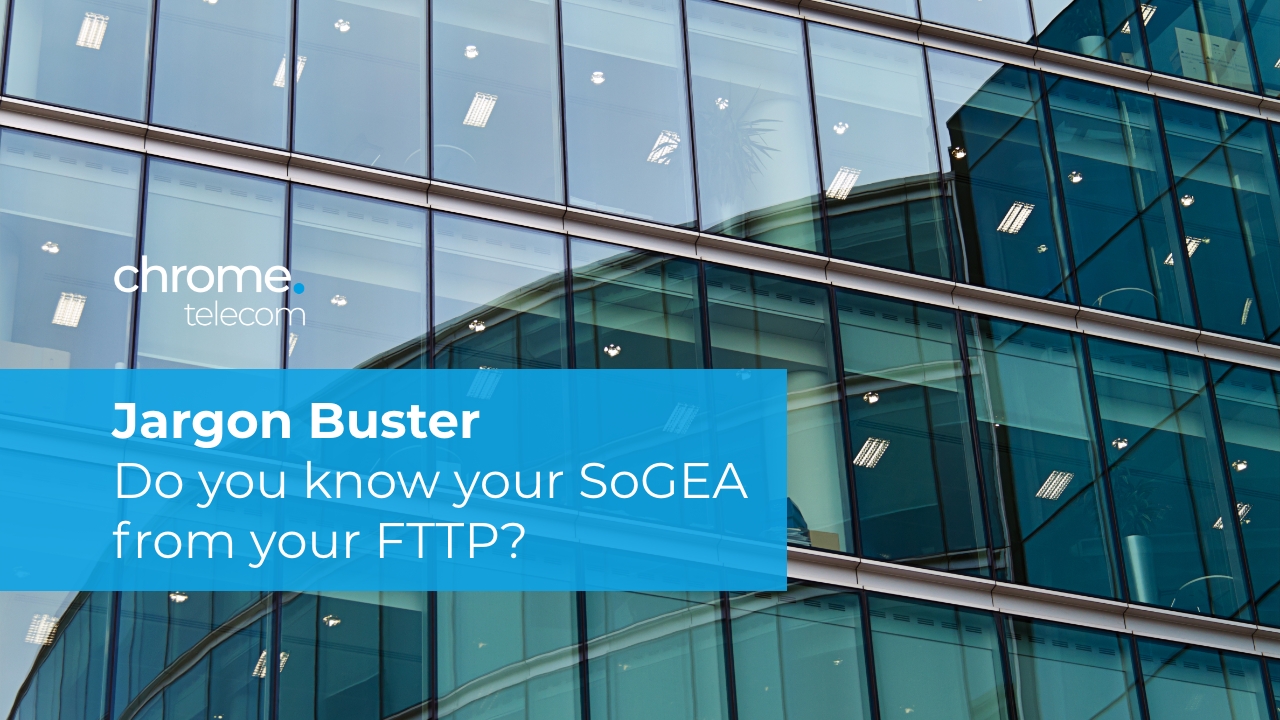So many types of broadband!
From SoGEA to FTTP, what’s the difference? Well, we thought it best to put together a guide which sheds some light on the different terms often found in the wide world of business broadband.
FTTP
What is FTTP?
Fibre to the Premises is high-speed ultrafast broadband. FTTP sends fibre optic messages from the exchange and directly to your business premises.
Why do businesses use FTTP?
FTTP users can enjoy the fastest fibre broadband at up to 1Gbps. Now available in many areas around the UK, with the correct routers FTTP is easy to install and is the best solution for fibre optic broadband.
FTTC
What is FTTC?
FTTC stands for Fibre to the Cabinet. It’s a broadband connection that delivers high-speed internet to homes and businesses via fibre-optic cables up to the nearest street cabinet. From there traditional copper phone lines are used for the final leg of the connection.
Why do businesses use FTTC?
FTTC offers fast broadband to a vast majority of homes and businesses in the UK. Businesses can order FTTC at the same time as ordering a copper line to be installed. Using FTTC as an option can often reduce maintenance costs, as you’ll only need to worry about your connection to the cabinet.
*Endangered species! BT Openreach are making changes to the UK landline infrastructure. Copper phone landlines are on course to be extinct by 2025.
SoGEA
What is SoGEA?
SoGEA stands for Single Order Generic Ethernet Access, which is a type of broadband technology used for delivering high-speed internet services to businesses. SoGEA supplies broadband without the phone line.
Why do businesses use SoGEA?
SoGea is ideal for businesses using internet-based services and work tools. It provides fast, reliable, and cost-effective internet access, reaching downloads of up to 80Mbs using the same reliable technology as FTTC.
DSL
What is DSL?
DSL (Digital Subscriber Line) is a type of broadband technology that provides internet over traditional copper telephone lines. It works by sending digital signals over the existing telephone network, which allows customers to use the internet and make phone calls at the same time.
Why businesses use DSL?
Businesses use DSL because the technology offers great speeds and a reliable connection. However, DSL is an older broadband technology that is gradually being phased out, we’d recommend an upgrade if you haven’t switched to fibre already.
*Endangered species! BT Openreach making changes to UK landline infrastructure. Copper phone landlines are on course to be extinct by 2025.
ADSL
What is ADSL?
ADSL (Asymmetric Digital Subscriber Line) is the most common form of DSL technology that provides high-speed internet over traditional copper telephone lines.
Why should businesses replace ADSL?
ADSL systems typically have limited bandwidth, which can slow down the speed of internet connections and cause bottlenecks when multiple users are trying to access the internet simultaneously. This can hinder productivity and negatively impact the overall performance of a business.
*Endangered species! BT Openreach making changes to UK landline infrastructure. Copper phone landlines are on course to be extinct by 2025.
Ethernet
What is Ethernet?
Ethernet is a manual connection that you’ll use to connect devices to your Local Area Network, allowing you to share data. Some Ethernet ports are cabled directly to your modem, others transmit the signals via WiFi.
Why do businesses need good Ethernet?
To keep your devices connected to your LAN!
Plugging your devices into your Ethernet ports and routers means you’ll be able to access your network.

